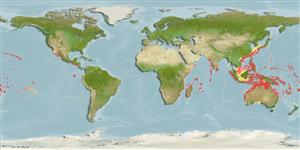Environment / Climate / Range
Ecology
Marine; demersal; non-migratory; depth range 15 - 110 m (Ref. 9790). Tropical, preferred ?
Indo-West Pacific: widespread, from off Natal, South Africa to Karachi, Maldives, South China Sea, Philippines, Irian Barat (Teluk Berau), Northwest Shelf of Australia, Timor and Arafura seas, Great Barrier Reef, Guadalcanal and Tonga.
Size / Weight / Age
Maturity: Lm ? range ? - ? cm
Max length : 11.0 cm TL male/unsexed; (Ref. 9790); common length : 7.0 cm TL male/unsexed; (Ref. 9790)
Short description
Morphology | Morphometrics
Dorsal
spines
(total): 9;
Dorsal
soft rays
(total): 11;
Anal
spines: 0;
Anal
soft rays: 10 - 11. No supraocular cirrus present. Infraorbital ridge entirely serrated over eye. Preopercular spines 3-5, slanting towards midline. Suborbital ridge with no smooth notch under eye. Antorbital margin with 2 antrorse spines. Lower side of head unicarinate. Lateral line scales frequently 30 or 31, anterior 2-6 (frequently 3) scales bearing spines. Iris lappet bilobed or crenate. Upper surface of eye smooth, no cirrus present. Pelvic fin with a prominent dark blotch in middle, a smaller dark blotch near base.
Taken by trawl over sand or coral rubble bottom at 15 to 110 m; also taken by SCUBA off coral or rocky slopes (Ref. 9790). Occurs near reefs (Ref 90102).
Life cycle and mating behavior
Maturity | Reproduction | Spawning | Eggs | Fecundity | Larvae
Knapp, L.W., 1999. Platycephalidae. Flatheads. p. 2385-2421. In K.E. Carpenter and V.H. Niem (eds.) FAO species identification guide for fishery purposes. The living marine resources of the Western Central Pacific. Volume 4. Bony fishes part 2 (Mugilidae to Carangidae). FAO, Rome. (Ref. 9790)
IUCN Red List Status (Ref. 115185)
CITES (Ref. 94142)
Not Evaluated
Threat to humans
Harmless
Human uses
Fisheries: of no interest
More information
Common namesSynonymsMetabolismPredatorsEcotoxicologyReproductionMaturitySpawningFecundityEggsEgg development
Age/SizeGrowthLength-weightLength-lengthLength-frequenciesMorphometricsMorphologyLarvaeLarval dynamicsRecruitmentAbundance
ReferencesAquacultureAquaculture profileStrainsGeneticsAllele frequenciesHeritabilityDiseasesProcessingMass conversion
Tools
Special reports
Download XML
Internet sources
Estimates of some properties based on models
Phylogenetic diversity index (Ref.
82805): PD
50 = 0.5039 [Uniqueness, from 0.5 = low to 2.0 = high].
Bayesian length-weight: a=0.00513 (0.00221 - 0.01193), b=3.04 (2.84 - 3.24), in cm Total Length, based on LWR estimates for this (Sub)family-body shape (Ref.
93245).
Trophic Level (Ref.
69278): 3.5 ±0.6 se; Based on size and trophs of closest relatives
Resilience (Ref.
69278): High, minimum population doubling time less than 15 months (Preliminary K or Fecundity.).
Vulnerability (Ref.
59153): Low vulnerability (13 of 100) .
